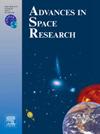声重力波穿过临界层到达上层大气
IF 2.8
3区 地球科学
Q2 ASTRONOMY & ASTROPHYSICS
引用次数: 0
摘要
利用高分辨率非线性数值模型,对声重力波(AGWs)从对流层向高层大气的传播进行了模拟研究。这些模拟考虑了包含临界水平的背景风廓线,其中水平风速等于水平AGW相速度。根据传统的大气波线性理论,垂直波长在临界水平附近趋近于零,导致从对流层传播的AGWs有很强的耗散,阻止它们到达高层大气。我们的数值模拟是使用沿地球表面传播的垂直速度的平面波扰动形式的波源进行的。大气中的急流可以用平均纬向风的高斯分布近似表示,其最大值分别位于海拔110公里和50公里处。计算表明,在高空临界水平以上,AGW振幅显著减小。在30-70公里高度的临界水平,部分波能可以穿透它们,进一步传播到上层大气。在非线性模型中,二次波模的增加发生在临界水位线附近。因此,在超过130 km的高度上,垂直波长长于一次AGW的模态占主导地位,在没有中层大气临界水平的情况下,这些次波的振幅可能超过一次AGW的振幅。本文章由计算机程序翻译,如有差异,请以英文原文为准。
Tunneling of acoustic-gravity waves through critical levels to the upper atmosphere
Using a high-resolution nonlinear numerical model, simulations are performed to study the propagation of acoustic-gravity waves (AGWs) from the troposphere into the upper atmosphere. These simulations take into account background wind profiles containing critical levels, where the horizontal wind velocity becomes equal to the horizontal AGW phase speed. According to conventional linear theories of atmospheric waves, the vertical wavelength approaches zero near critical levels, resulting in strong dissipation of AGWs propagating from the troposphere and preventing them from reaching the upper atmosphere. Our numerical simulations are carried out using wave sources in the form of plain wave perturbations of vertical velocity, propagating along the Earth’s surface. Jet streams in the atmosphere are approximated by Gaussian profiles of the mean zonal wind with maxima located at altitudes of 110 km and 50 km. Calculations reveal that AGW amplitudes are significantly reduced above the high-altitude critical levels. For the critical levels at altitudes 30–70 km, part of wave energy can penetrate through them and propagate further into the upper atmosphere. In the nonlinear model, increased generation of secondary wave modes occur near the critical level. Therefore, modes with vertical wavelengths longer than that of the primary AGW dominate at altitudes exceeding 130 km, where amplitudes of these secondary waves may surpass the amplitudes of the primary AGW in the absence of middle atmosphere critical levels.
求助全文
通过发布文献求助,成功后即可免费获取论文全文。
去求助
来源期刊

Advances in Space Research
地学天文-地球科学综合
CiteScore
5.20
自引率
11.50%
发文量
800
审稿时长
5.8 months
期刊介绍:
The COSPAR publication Advances in Space Research (ASR) is an open journal covering all areas of space research including: space studies of the Earth''s surface, meteorology, climate, the Earth-Moon system, planets and small bodies of the solar system, upper atmospheres, ionospheres and magnetospheres of the Earth and planets including reference atmospheres, space plasmas in the solar system, astrophysics from space, materials sciences in space, fundamental physics in space, space debris, space weather, Earth observations of space phenomena, etc.
NB: Please note that manuscripts related to life sciences as related to space are no more accepted for submission to Advances in Space Research. Such manuscripts should now be submitted to the new COSPAR Journal Life Sciences in Space Research (LSSR).
All submissions are reviewed by two scientists in the field. COSPAR is an interdisciplinary scientific organization concerned with the progress of space research on an international scale. Operating under the rules of ICSU, COSPAR ignores political considerations and considers all questions solely from the scientific viewpoint.
 求助内容:
求助内容: 应助结果提醒方式:
应助结果提醒方式:


